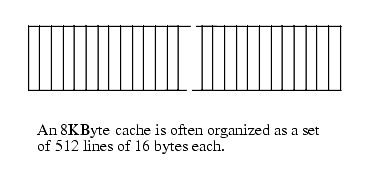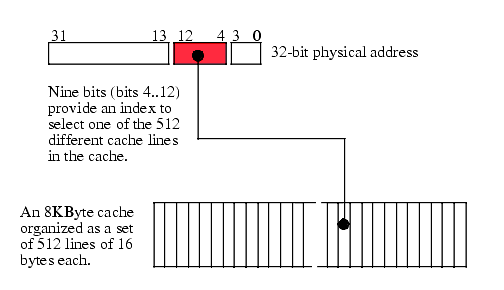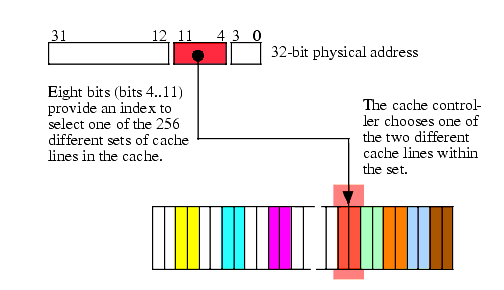6.5 Cache Architecture
Up to this point, cache has been this magical place that automatically stores data when we need it, perhaps fetching new data as the CPU requires it. However, a good question is "how exactly does the cache do this?" Another might be "what happens when the cache is full and the CPU is requesting additional data not in the cache?" In this section, we'll take a look at the internal cache organization and try to answer these questions along with a few others.
The basic idea behind a cache is that a program only access a small amount of data at a given time. If the cache is the same size as the typical amount of data the program access at any one given time, then we can put that data into the cache and access most of the data at a very high speed. Unfortunately, the data rarely sits in contiguous memory locations; usually, there's a few bytes here, a few bytes there, and some bytes somewhere else. In general, the data is spread out all over the address space. Therefore, the cache design has got to accommodate the fact that it must map data objects at widely varying addresses in memory.
As noted in the previous section, cache memory is not organized as a group of bytes. Instead, cache organization is usually in blocks of cache lines with each line containing some number of bytes (typically a small number that is a power of two like 16, 32, or 64), see Figure 6.2.

Figure 6.2 Possible Organization of an 8 Kilobyte Cache
The idea of a cache system is that we can attach a different (non-contiguous) address to each of the cache lines. So cache line #0 might correspond to addresses $10000..$1000F and cache line #1 might correspond to addresses $21400..$2140F. Generally, if a cache line is n bytes long (n is usually some power of two) then that cache line will hold n bytes from main memory that fall on an n-byte boundary. In this example, the cache lines are 16 bytes long, so a cache line holds blocks of 16 bytes whose addresses fall on 16-byte boundaries in main memory (i.e., the L.O. four bits of the address of the first byte in the cache line are always zero).
When the cache controller reads a cache line from a lower level in the memory hierarchy, a good question is "where does the data go in the cache?" The most flexible cache system is the fully associative cache. In a fully associative cache subsystem, the caching controller can place a block of bytes in any one of the cache lines present in the cache memory. While this is a very flexible system, the flexibility is not without cost. The extra circuitry to achieve full associativity is expensive and, worse, can slow down the memory subsystem. Most L1 and L2 caches are not fully associative for this reason.
At the other extreme is the direct mapped cache (also known as the one-way set associative cache). In a direct mapped cache, a block of main memory is always loaded into the same cache line in the cache. Generally, some number of bits in the main memory address select the cache line. For example, Figure 6.3 shows how the cache controller could select a cache line for an 8 Kilobyte cache with 16-byte cache lines and a 32-bit main memory address. Since there are 512 cache lines, this example uses bits four through twelve to select one of the cache lines (bits zero through three select a particular byte within the 16-byte cache line). The direct-mapped cache scheme is very easy to implement. Extracting nine (or some other number of) bits from the address and using this as an index into the array of cache lines is trivial and fast. However, direct-mapped caches to suffer from some other problems.

Figure 6.3 Selecting a Cache Line in a Direct-mapped Cache
Perhaps the biggest problem with a direct-mapped cache is that it may not make effective use of all the cache memory. For example, the cache scheme in Figure 6.3 maps address zero to cache line #0. It also maps address $2000 (8K), $4000 (16K), $6000 (24K), $8000 (32K), and, in fact, it maps every address that is an even multiple of eight kilobytes to cache line #0. This means that if a program is constantly accessing data at addresses that are even multiples of 8K and not accessing any other locations, the system will only use cache line #0, leaving all the other cache lines unused. Each time the CPU requests data at an address that is not at an address within cache line #0, the CPU will have to go down to a lower level in the memory hierarchy to access the data. In this pathological case, the cache is effectively limited to the size of one cache line. Had we used a fully associative cache organization, each access (up to 512 cache lines' worth) could have their own cache line, thus improving performance.
If a fully associative cache organization is too complex, expensive, and slow to implement, but a direct-mapped cache organization isn't as good as we'd like, one might ask if there is a compromise that gives us more capability that a direct-mapped approach without all the complexity of a fully associative cache. The answer is yes, we can create an n-way set associative cache which is a compromise between these two extremes. The idea here is to break up the cache into sets of cache lines. The CPU selects a particular set using some subset of the address bits, just as for direct-mapping. Within each set there are n cache lines. The caching controller uses a fully associative mapping algorithm to select one of the n cache lines within the set.
As an example, an 8 kilobyte two-way set associative cache subsystem with 16-byte cache lines organizes the cache as a set of 256 sets with each set containing two cache lines ("two-way" means each set contains two cache lines). Eight bits from the memory address select one of these 256 different sets. Then the cache controller can map the block of bytes to either cache line within the set (see Figure 6.4). The advantage of a two-way set associative cache over a direct mapped cache is that you can have two accesses on 8 Kilobyte boundaries (using the current example) and still get different cache lines for both accesses. However, once you attempt to access a third memory location at an address that is an even multiple of eight kilobytes you will have a conflict.

Figure 6.4 A Two-Way Set Associative Cache
A two-way set associative cache is much better than a direct-mapped cache and considerably less complex than a fully associative cache. However, if you're still getting too many conflicts, you might consider using a four-way set associative cache. A four-way set associative cache puts four associative cache lines in each block. In the current 8K cache example, a four-way set associative example would have 128 sets with each set containing four cache lines. This would allow up to four accesses to an address that is an even multiple of eight kilobytes before a conflict would occur.
Obviously, we can create an arbitrary m-way set associative cache (well, m does have to be a power of two). However, if m is equal to n, where n is the number of cache lines, then you've got a fully associative cache with all the attendant problems (complexity and speed). Most cache designs are direct-mapped, two-way set associative, or four-way set associative. The 80x86 family CPUs use all three (depending on the CPU and cache).
Although this section has made direct-mapped cache look bad, they are, in fact, very effective for many types of data. In particular, they are very good for data that you access in a sequential rather than random fashion. Since the CPU typically executes instructions in a sequential fashion, instructions are a good thing to put into a direct-mapped cache. Data access is probably a bit more random access, so a two-way or four-way set associative cache probably makes a better choice.
Because access to data and instructions is different, many CPU designers will use separate caches for instructions and data. For example, the CPU designer could choose to implement an 8K instruction cache and an 8K data cache rather than a 16K unified cache. The advantage is that the CPU designer could choose a more appropriate caching scheme for instructions versus data. The drawback is that the two caches are now each half the size of a unified cache and you may get fewer cache misses from a unified cache. The choice of an appropriate cache organization is a difficult one and can only be made after analyzing lots of running programs on the target processor. How to choose an appropriate cache format is beyond the scope of this text, just be aware that it's not an easy choice you can make by reading some textbook.
Thus far, we've answered the question "where do we put a block of data when we read it into the cache?" An equally important question we ignored until now is "what happens if a cache line isn't available when we need to read data from memory?" Clearly, if all the lines in a set of cache lines contain data, we're going to have to replace one of these lines with the new data. The question is, "how do we choose the cache line to replace?"
For a direct-mapped (one-way set associative) cache architecture, the answer is trivial. We replace exactly the block that the memory data maps to in the cache. The cache controller replaces whatever data was formerly in the cache line with the new data. Any reference to the old data will result in a cache miss and the cache controller will have to bring that data into the cache replacing whatever data is in that block at that time.
For a two-way set associative cache, the replacement algorithm is a bit more complex. Whenever the CPU references a memory location, the cache controller uses some number of the address bits to select the set that should contain the cache line. Using some fancy circuity, the caching controller determines if the data is already present in one of the two cache lines in the set. If not, then the CPU has to bring the data in from memory. Since the main memory data can go into either cache line, somehow the controller has to pick one or the other. If either (or both) cache lines are currently unused, the selection is trivial: pick an unused cache line. If both cache lines are currently in use, then the cache controller must pick one of the cache lines and replace its data with the new data. Ideally, we'd like to keep the cache line that will be referenced first (that is, we want to replace the one whose next reference is later in time). Unfortunately, neither the cache controller nor the CPU is omniscient, they cannot predict which is the best one to replace. However, remember the principle of temporal locality (see "Cache Memory" on page 153): if a memory location has been referenced recently, it is likely to be referenced again in the very near future. A corollary to this is "if a memory location has not been accessed in a while, it is likely to be a long time before the CPU accesses it again." Therefore, a good replacement policy that many caching controllers use is the "least recently used" or LRU algorithm. The idea is to pick the cache line that was not most frequently accessed and replace that cache line with the new data. An LRU policy is fairly easy to implement in a two-way set associative cache system. All you need is a bit that is set to zero whenever the CPU accessing one cache line and set it to one when you access the other cache line. This bit will indicate which cache line to replace when a replacement is necessary. For four-way (and greater) set associative caches, maintaining the LRU information is a bit more difficult, which is one of the reasons the circuitry for such caches is more complex. Other possible replacement policies include First-in, First-out1 (FIFO) and random. These are easier to implement than LRU, but they have their own problems.
The replacement policies for four-way and n-way set associative caches are roughly the same as for two-way set associative caches. The major difference is in the complexity of the circuit needed to implement the replacement policy (see the comments on LRU in the previous paragraph).
Another problem we've overlooked in this discussion on caches is "what happens when the CPU writes data to memory?" The simple answer is trivial, the CPU writes the data to the cache. However, what happens when the cache line containing this data is replaced by incoming data? If the contents of the cache line is not written back to main memory, then the data that was written will be lost. The next time the CPU reads that data, it will fetch the original data values from main memory and the value written is lost.
Clearly any data written to the cache must ultimately be written to main memory as well. There are two common write policies that caches use: write-back and write-through. Interestingly enough, it is sometimes possible to set the write policy under software control; these aren't hardwired into the cache controller like most of the rest of the cache design. However, don't get your hopes up. Generally the CPU only allows the BIOS or operating system to set the cache write policy, your applications don't get to mess with this. However, if you're the one writing the operating system...
The write-through policy states that any time data is written to the cache, the cache immediately turns around and writes a copy of that cache line to main memory. Note that the CPU does not have to halt while the cache controller writes the data to memory. So unless the CPU needs to access main memory shortly after the write occurs, this writing takes place in parallel with the execution of the program. Still, writing a cache line to memory takes some time and it is likely that the CPU (or some CPU in a multiprocessor system) will want to access main memory during this time, so the write-through policy may not be a high performance solution to the problem. Worse, suppose the CPU reads and writes the value in a memory location several times in succession. With a write-through policy in place the CPU will saturate the bus with cache line writes and this will have a very negative impact on the program's performance. On the positive side, the write-through policy does update main memory with the new value as rapidly as possible. So if two different CPUs are communicating through the use of shared memory, the write-through policy is probably better because the second CPU will see the change to memory as rapidly as possible when using this policy.
The second common cache write policy is the write-back policy. In this mode, writes to the cache are not immediately written to main memory; instead, the cache controller updates memory at a later time. This scheme tends to be higher performance because several writes to the same variable (or cache line) only update the cache line, they do not generate multiple writes to main memory.
Of course, at some point the cache controller must write the data in cache to memory. To determine which cache lines must be written back to main memory, the cache controller usually maintains a dirty bit with each cache line. The cache system sets this bit whenever it writes data to the cache. At some later time the cache controller checks this dirty bit to determine if it must write the cache line to memory. Of course, whenever the cache controller replaces a cache line with other data from memory, it must first write that cache line to memory if the dirty bit is set. Note that this increases the latency time when replacing a cache line. If the cache controller were able to write dirty cache lines to main memory while no other bus access was occurring, the system could reduce this latency during cache line replacement.
A cache subsystem is not a panacea for slow memory access. In order for a cache system to be effective the software must exhibit locality of reference. If a program accesses memory in a random fashion (or in a fashion guaranteed to exploit the caching controller's weaknesses) then the caching subsystem will actually cause a big performance drop. Fortunately, real-world programs do exhibit locality of reference, so most programs will benefit from the presence of a cache in the memory subsystem.
Another feature to the cache subsystem on modern 80x86 CPUs is that the cache automatically handles many misaligned data references. As you may recall from an earlier chapter, there is a penalty for accesses larger data objects (words or dwords) at an address that is not an even multiple of that object's size. As it turns out, by providing some fancy logic, Intel's designers have eliminated this penalty as long as the data access is completely within a cache line. Therefore, accessing a word or double word at an odd address does not incur a performance penalty as long as the entire object lies within the same cache line. However, if the object crosses a cache line, then there will be a performance penalty for the memory access.
1This policy does exhibit some anomalies. These problems are beyond the scope of this chapter, but a good text on architecture or operating systems will discuss the problems with the FIFO replacement policy.
|